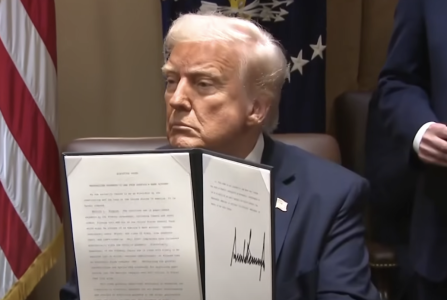Say goodbye to paper checks: How the US Treasury decision could affect your money
By
Veronica E.
- Replies 0
In a groundbreaking move that’s reshaping the way Americans receive and send money, the US Treasury is putting an end to paper checks.
This decision stems from an executive order signed by President Donald Trump.
It is set to change how millions of people handle tax refunds and Social Security payments.
We know change can feel overwhelming, especially when it involves your hard-earned money.
So, let’s break down what this means for you and how you can adapt to the new digital world with ease.

The End of an Era: Paper Checks Phased Out
The Treasury’s six-month timeline to eliminate paper checks is a big step toward a digital-first approach.
By September 30, all government departments and agencies are expected to switch to electronic funds transfers (EFT), such as direct deposit, debit/credit card payments, digital wallets, and real-time transfers.
This change will also affect payments made to the federal government, with some exceptions.
Why the Sudden Change?
The Trump administration’s goal is to “modernize how the government handles money,” citing the inefficiencies, costs, and risks of paper-based payments.
Digital payments are expected to be more efficient, cost-effective, and secure, reducing fraud and lost payments.
The White House has pointed to the high costs and risks of paper checks as key reasons for this shift.
Also read: What’s happening with Social Security? Many seniors aren’t feeling reassured
The Impact on Social Security Recipients
For over 450,000 individuals still receiving paper Social Security checks, this change will have a significant impact.
Transitioning to electronic payments may be difficult, particularly for older adults who may not be familiar with digital banking systems.
There are concerns about vulnerable populations who may not have reliable internet access.
However, the Treasury Secretary is working on a plan to help those who face challenges, ensuring that no one is left behind.
Also read: Retirees in these 9 states could see their Social Security checks shrink—check if you’re affected
The Strain on Social Security Administration Resources
Many individuals may need assistance updating their payment information, which could put a strain on the Social Security Administration's resources.
Some people might not be able to make changes online and will require in-person assistance, which could be further impacted by budget cuts and the closure of local offices.
The Rise of Mail Theft
One reason for this move is the rise in mail theft.
Last summer, two former postal workers were charged with stealing over $4 million in US Treasury checks.
The FBI has reported a significant increase in check fraud related to mail theft, with cases nearly doubling from 2021 to 2023.
In just six months, fraud linked to mail theft totaled more than $688 million.
Also read: Lawsuit challenges US Treasury over DOGE access—is your personal data at risk?
Legislative Measures Against Mail Fraud
To address the rising issue of mail theft, bipartisan legislation is currently progressing through Congress.
Congresswoman Nicole Malliotakis (R-NY), along with Reps. David Kustoff (R-TN) and Terri Sewell (D-AL), introduced the bipartisan Recovery of Stolen Checks Act.
“Many of my constituents are hardworking taxpayers, and when a check is lost or stolen, it directly affects their livelihood,” Malliotakis stated.
“Reissuing payments through direct deposit is a practical solution to this widespread issue and will help protect taxpayers from criminals who steal their hard-earned money.”
The Recovery of Stolen Checks Act would allow taxpayers to request a direct deposit if their IRS tax refund check is stolen.
What You Can Do Today
If you’re concerned about the security of your tax refund or Social Security payments, here are some steps you can take today:
While this move away from paper checks may feel sudden, it’s part of a larger trend toward digital financial services.
For our GrayVine community, adapting to this change is simply another step in embracing technology.
Stay informed, seek help when needed, and enjoy the added security that digital payments offer.
Read next: Is your budget ready for what's next? Rising rates and costs could hit your wallet harder than expected

We’d love to hear your thoughts on this transition. Have you already made the switch to digital payments, or are you finding the change challenging? Share your experiences in the comments to help fellow readers navigate this shift more smoothly.
This decision stems from an executive order signed by President Donald Trump.
It is set to change how millions of people handle tax refunds and Social Security payments.
We know change can feel overwhelming, especially when it involves your hard-earned money.
So, let’s break down what this means for you and how you can adapt to the new digital world with ease.

Trump signs executive order to update Treasury payment system and combat fraud. Image Source: YouTube / Forbes Breaking News.
The End of an Era: Paper Checks Phased Out
The Treasury’s six-month timeline to eliminate paper checks is a big step toward a digital-first approach.
By September 30, all government departments and agencies are expected to switch to electronic funds transfers (EFT), such as direct deposit, debit/credit card payments, digital wallets, and real-time transfers.
This change will also affect payments made to the federal government, with some exceptions.
Why the Sudden Change?
The Trump administration’s goal is to “modernize how the government handles money,” citing the inefficiencies, costs, and risks of paper-based payments.
Digital payments are expected to be more efficient, cost-effective, and secure, reducing fraud and lost payments.
The White House has pointed to the high costs and risks of paper checks as key reasons for this shift.
Also read: What’s happening with Social Security? Many seniors aren’t feeling reassured
The Impact on Social Security Recipients
For over 450,000 individuals still receiving paper Social Security checks, this change will have a significant impact.
Transitioning to electronic payments may be difficult, particularly for older adults who may not be familiar with digital banking systems.
There are concerns about vulnerable populations who may not have reliable internet access.
However, the Treasury Secretary is working on a plan to help those who face challenges, ensuring that no one is left behind.
Also read: Retirees in these 9 states could see their Social Security checks shrink—check if you’re affected
The Strain on Social Security Administration Resources
Many individuals may need assistance updating their payment information, which could put a strain on the Social Security Administration's resources.
Some people might not be able to make changes online and will require in-person assistance, which could be further impacted by budget cuts and the closure of local offices.
The Rise of Mail Theft
One reason for this move is the rise in mail theft.
Last summer, two former postal workers were charged with stealing over $4 million in US Treasury checks.
The FBI has reported a significant increase in check fraud related to mail theft, with cases nearly doubling from 2021 to 2023.
In just six months, fraud linked to mail theft totaled more than $688 million.
Also read: Lawsuit challenges US Treasury over DOGE access—is your personal data at risk?
Legislative Measures Against Mail Fraud
To address the rising issue of mail theft, bipartisan legislation is currently progressing through Congress.
Congresswoman Nicole Malliotakis (R-NY), along with Reps. David Kustoff (R-TN) and Terri Sewell (D-AL), introduced the bipartisan Recovery of Stolen Checks Act.
“Many of my constituents are hardworking taxpayers, and when a check is lost or stolen, it directly affects their livelihood,” Malliotakis stated.
“Reissuing payments through direct deposit is a practical solution to this widespread issue and will help protect taxpayers from criminals who steal their hard-earned money.”
The Recovery of Stolen Checks Act would allow taxpayers to request a direct deposit if their IRS tax refund check is stolen.
What You Can Do Today
If you’re concerned about the security of your tax refund or Social Security payments, here are some steps you can take today:
- File your taxes electronically and use the "Where’s My Refund" tool to check your refund status.
- If your refund is delayed or stolen, request a refund trace with the IRS.
- Stay informed about federal refund processing times.
- Report any stolen, lost, or destroyed checks from state programs to your State Comptroller’s Office.
While this move away from paper checks may feel sudden, it’s part of a larger trend toward digital financial services.
For our GrayVine community, adapting to this change is simply another step in embracing technology.
Stay informed, seek help when needed, and enjoy the added security that digital payments offer.
Read next: Is your budget ready for what's next? Rising rates and costs could hit your wallet harder than expected
Key Takeaways
- President Trump has signed an executive order aiming to transition federal payments from paper checks to electronic methods by September 30, with some exceptions.
- This change will affect tax refunds and Social Security payments, requiring those who currently receive paper checks to adopt electronic payment methods.
- Vulnerable populations and those without reliable internet access may face challenges, but a process will be developed to address cases of undue hardship.
- The shift to electronic payments is intended to modernize government transactions, reduce costs, and minimize the risks associated with paper-based payments, such as fraud, lost payments, and mail theft.
We’d love to hear your thoughts on this transition. Have you already made the switch to digital payments, or are you finding the change challenging? Share your experiences in the comments to help fellow readers navigate this shift more smoothly.






